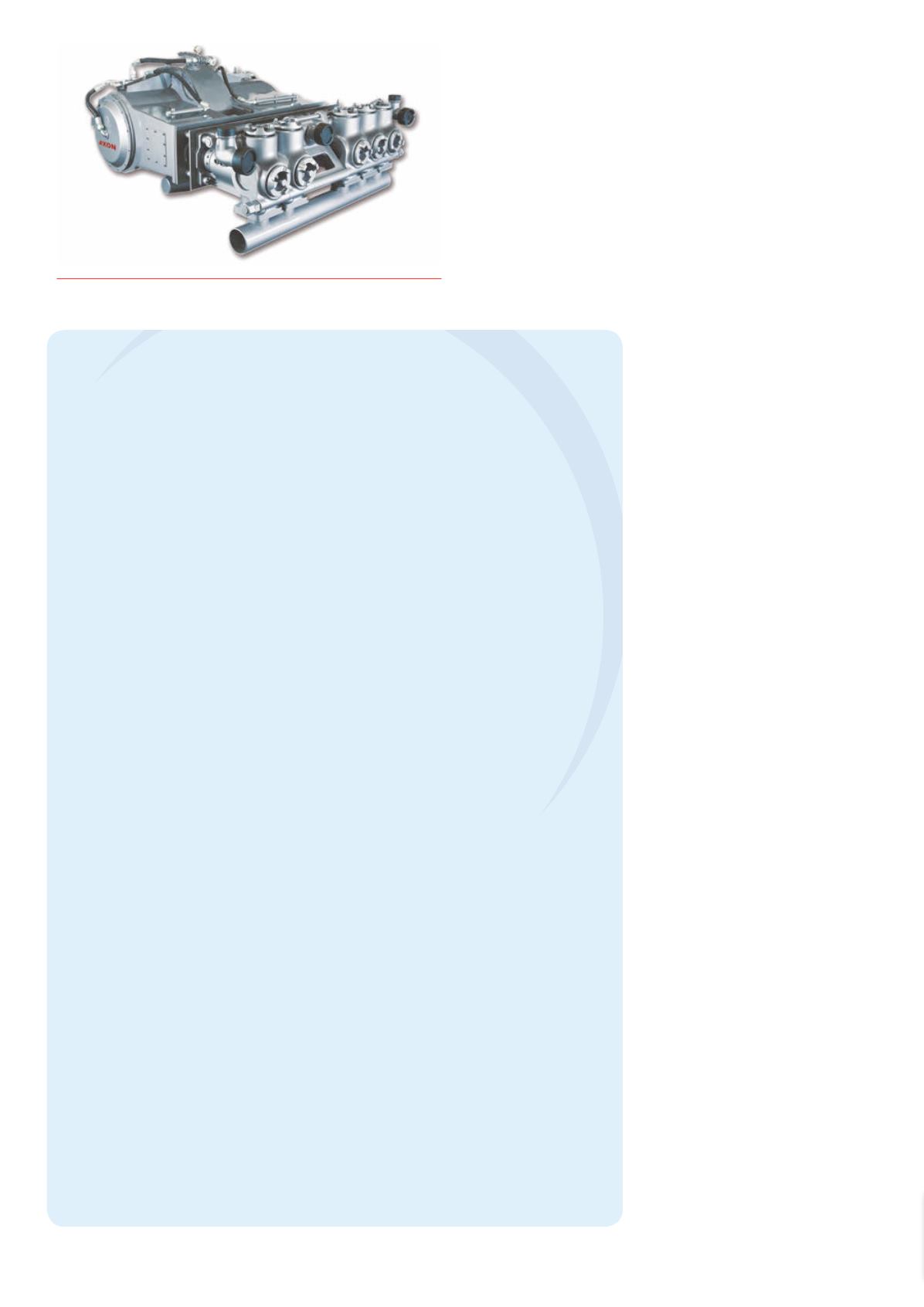
48 |
Oilfield Technology
December
2014
Challenges
Challenges related to fluid end life generally stem from fatigue stress,
potentially compounded by chemical effects of proppant on steel.
Abrasivemedia present in the proppant, as well as the geometric
makeup of the fluid end, are also contributing factors.
Pumps are generally available in either Triplex (three pressure
plungers), or Quintuplex (five pressure plungers) variations. Both
configurations are typically operated by a crankmechanism that can
run up to 300 rpm. (This is equivalent to 300 pressure cycles/min. in
the fluid end.)
Each pressure cycle consists of a suction stroke to draw the
proppant into the fluid end before it is pressurised in the exhaust
stroke. (Throughout this cycle, the direction of flow is controlled
utilising check valve arrangements within the fluid end.) In a fraction
of a second, the pressure profile within the cycle vacillates froma
negative pressure to a high pressure. The
constant exposure to negative pressure
(fluid being drawn in the fluid end),
followed by the pressuring stroke (up to
20 000 psi), is repeated up to five times a
second. Consequently, the rate of change
and ‘shock loading’ derived from this
continuous cycle results in significant
strain on the fluid end structure,
ultimately leading to fatigue stress.
During fracking operations, certain
proppants are utilised because their
chemical composition aids this specific
pumping application. However, these
chemicals can also detrimentally affect
the fluid ends by altering the chemical
make‑up of exposed surfaces. For
example, well service pumps with high
concentrations of hydrogen sulfide
(H
2
S) are particularly prone to corrosion.
Due to this chemical reaction, severe
performance restrictions are applied to
the fluid ends during operation.
In addition, turbulent flow can be
significant as fluid is drawn into the
fluid end. Particulates in the fluid act
as highly abrasivemedia, ultimately
resulting in erosion. Because of this,
geometric make‑up is especially critical
in influencing both flow dynamics and
fatigue stressing. For instance, sharp
geometric deviations in the fluid ends can
cause stress concentrations, leading to
possible fatigue cracking and turbulent
flow.
Searchingfor solutions
In the last decade, the industry has
developed and refined its fluid ends
to provide operators with solutions to
prolong fluid end life whilemaintaining
high pressures. For example, tougher
carbon steels and/or stainless steels were
developed to provide increased durability
on the internal surfaces to reduce erosive
effects and resist fatigue cracking. These
properties must be balanced with the
increased difficulty of machining tougher
Case study
Challenge
Prolong fluid end life whilemaintaining high pressures.
Response
AXON fluid end development addresses several issueswithmonoblock‑style fluid ends to provide a
modular fluid end unit with interchangeable segments. The singular fluid ends are assembled to produce
Triplex andQuintuplex variants that precisely fit into the identical footprint as theOEMmonoblock versions.
Advantages
High tensile steel forgings
Ì
AISI 4330 Modified ‑ 120 ksi min yield.
Optimised design.
Ì
Utilises current OEM internal elements (not supplied as standard) and does not require special tools
or training to convert frommonoblock to modular assembly.
Ì
Internal geometry modification to reduce high stress areas to decrease fatigue loading and extend
life.
Ì
External geometry optimised to provide compressive forces in key stress areas, reducing fatigue
stress affects.
Proven field trials extending fluid end life
Ì
600 ‑ 1000 hours (depending on application) versus 250 ‑ 450 hours for monoblock.
Available inmultiple options
Ì
Currently offering 2250 and 2500hp variants, triplex or quintuplex (same module).
Decreased operating costs
Ì
Reduced ongoing replacement cost (replace only the failed pot).
Ì
Reduced inventory holding cost (replace only the affected plunger bore).
Field-driven data
Current market monoblock fluid end life:
Ì
250 ‑ 450 hours (depending of operating conditions).
AXONQuintuplex Replacement fluid end life: field test.
Ì
First fatigue between 600 ‑ 800 hours.
Ì
Two pots failed.
Ì
Three remaining pots have in excess of 1000 hours.
Conclusion
Based on a 3000 hour run rate, utilisingmodular fluid ends (versus standardmonoblock fluid ends) results
in estimated savings of over 150%of operational/maintenance costs.
* Patent Pending – Application Serial No. 13/082,565.
Figure 1.
Configurable quintuplex pumpwithmodular fluid end
assembly.


